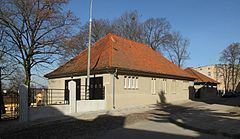Completed 1913 (1913) | Opened 1913 | |
 | ||
Similar Mossehaus, Schocken Department Store - Stu, Red Banner Textile Fa, Albert Einstein Science, Einstein Tower | ||
The Mendelsohn House (Polish: Dom Mendelsohna) is a former Jewish Tahara house (Bet Tahara) in Olsztyn (Allenstein), Poland, today used as a center for intercultural dialogue.
Contents
Map of Mendelsohn House, Olsztyn, Poland
Tahara House
The Tahara house, completed in 1913, was the first building designed by Erich Mendelsohn and the only one in his hometown of Allenstein. A smaller gatehouse, the residence of the cemetery's gardener, is part of the complex. The passage between both buildings was used as the main entrance of the cemetery. The structure was influenced by Joseph Maria Olbrich's architecture.
The circumstances of Mendelsohn's commissioning remain unclear. The commissioning was probably influenced by Mendelsohn's father, a venerable member of the Jewish community of Allenstein. The house was equipped with rooms for the ritual washing of the corpses, a mourning hall and a mortuary leading to the adjacent Jewish cemetery. The interior is dominated by the central hall, a pyramidal wooden dome with mosaic decoration. A frieze with Hebrew lettering decorates the room. The design is only partially characterized by Jewish symbolism, simplified geometric elements show the influence of Art Nouveau and expressionism.
With the rise of Adolf Hitler in Germany, the cemetery was defiled by the Nazis in early 1936 but was not directly affected by the Kristallnacht riots of 1938. In 1943 the state of construction of the building was described as good, the gatehouse was still inhabited.
In 1939 Allenstein's Jewish community counted 138 members (448 in 1933) In summer 1942 the Germans deported the Jews of Allenstein to the Minsk Ghetto and Theresienstadt and murdered them in the Holocaust. The Jewish community of Allenstein ceased to exist.
Municipal archive
After World War II the region became part of Poland. The use of the building during the immediate post war years is unknown.
After an anti-semitic campaign in Poland the remains of the cemetery were levelled to the ground in 1968 and the building was used as a magazine by the municipal archive of Olsztyn. Construction drawings of 1971 show several significant changes like the installation of a staircase between the main floor and the basement. This alteration resulted in the loss of most wall decorations, original floors in the wings and the original ceiling. New concrete floors destroyed the frieze in the main hall.
Mendelsohn House
In 2005, Borussia initiated the reconstruction of the building which began in 2008. Borussia is a Polish Foundation founded in 1990 and dedicated to the unbiased research of East Prussian heritage in the area, which had been tabooed for decades in Communist Poland. The building and the adjacent cemetery were acquired by the Foundation for the Preservation of Jewish Heritage in Poland. Since 2013 the building has been used as a center for intercultural dialogue by the "Borussia" Foundation and was named Mendelsohn House (Dom Mendelsohna) in memory of its architect.
